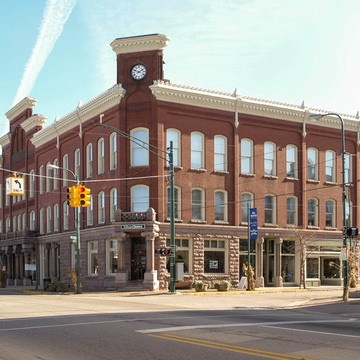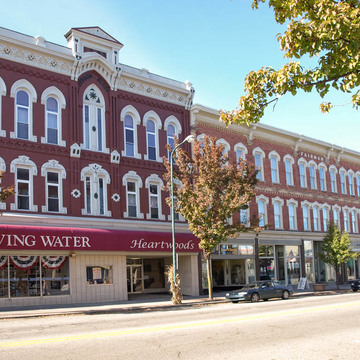You are here
Nisbett Building (Nisbett-Fairman Residences)
This ambitious neo-Romanesque commercial block, built intermittently over a fourteen-year period, presides over the main intersection of the business district. Daniel Comstock, president of the Mecosta County Savings Bank, began construction on the portion of the building that fronts S. Michigan Avenue in 1885 and when this phase was completed, the bank moved into the corner rooms. With the onset of the Panic of 1893 the bank closed, construction abruptly was halted, and the building went into the receivership of the Michigan Trust Company of Grand Rapids. In 1900 local publisher William Nisbett (1846–1923) purchased the building for $20,000. He completed much of the construction, hiring Fisher, a Grand Rapids builder, to create a hotel in a large portion of the building that fronts Maple Street. The rest of the building contained stores, offices, a lodge, and an armory space.
The weighty first story is faced with Vermont granite and distinguished by polished columns that vaguely resemble the Composite order that support the main entrance portico. The red brick exterior walls of the upper stories are broken by bays that are delineated by pilasters and that contain segmental-arched windows. The decorative cornice line is punctuated by parapets that marked the main entrances below. The building certainly was one of the largest and most ornate in Mecosta County at the turn of the twentieth century. More recently, in 2004, and in response to the increasing demand for high-quality affordable housing in a downtown location, the Big Rapids Housing Commission and Hollander Development Company rehabilitated the Nisbett and the Fairman (S. Michigan Avenue at Maple Street) buildings for affordable senior housing. Public and private funding coupled with historic preservation tax credits financed the Nisbett-Fairman Residences.
Writing Credits
If SAH Archipedia has been useful to you, please consider supporting it.
SAH Archipedia tells the story of the United States through its buildings, landscapes, and cities. This freely available resource empowers the public with authoritative knowledge that deepens their understanding and appreciation of the built environment. But the Society of Architectural Historians, which created SAH Archipedia with University of Virginia Press, needs your support to maintain the high-caliber research, writing, photography, cartography, editing, design, and programming that make SAH Archipedia a trusted online resource available to all who value the history of place, heritage tourism, and learning.
















